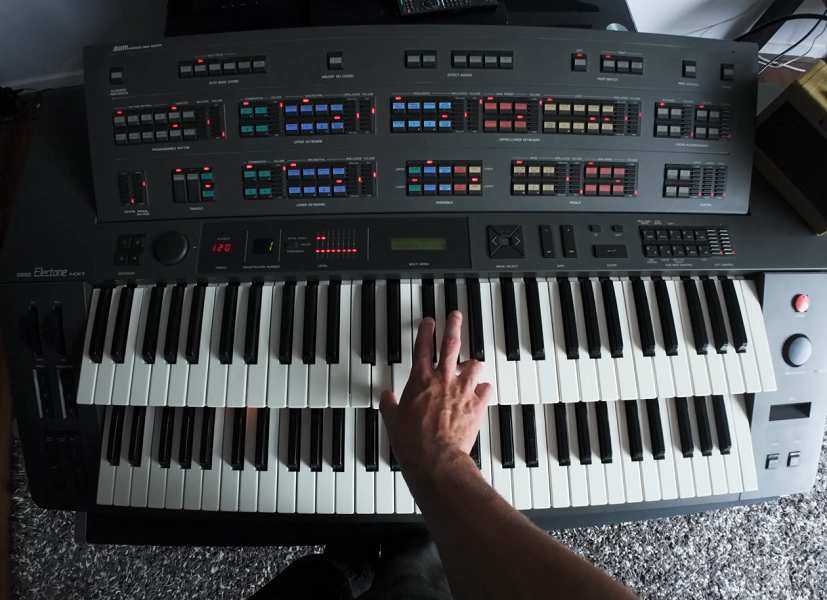
Yamaha Electone HX-1
Gosh, this is truly an absolute beast of a... synthesizer, really.
In fact even Yamaha themselves seemed to have seen this more as a synthesizer, rather than the organ it was supposed to be, as they released PC software to fully program the FM voices. For more on that check out my HX Expander project.
It's fully modular, has up to 16 operators in a voice and allows for custom user algorithms. Yeah, this is absolute insanity the likes of which I honestly haven't seen before.
Oh and as a bonus: it sounds surprisingly warm and rich, way better than most FM synths.
So allow me to take you on a journey in which I open 'er up and expose the hidden magic.
THIS PAGE IS A WORK IN PROGRESS.
About the Electone HX (and HS) series of organs
Yamaha is well known for their (flagship) FM synthesizers, having pioneered FM synthesis if you will. The most well known example is of course the DX7, with the DX series in general having been their most popular. These have eventually evolved into the ModX series we have today.

And then there was Yamaha's series of Electone organs. Quite a legacy that spans all the way from 1959, with the D-1, to today.
Beginning of course with analog organs, for which Yamaha's engineers got to experiment with all sorts of in-house tech. Such as the PASS technology that was also used in the CS80. A lot of the nice analog filters Yamaha made for their synthesizers can be found in their analog organs as well, usually for brass-esque and "wah" sounds.
And later, when integrated circuits became commonplace, of course their very own FM technologies. Don't be surprised if you find DX synth chips inside your Electone organ. For example the Electone HS series has the 4-operator chips (YM2414) found in the TX81z and DX11. And the Electone HX series builds upon that even further.
And that brings me to the HX-1, which is displayed as a full set to the left. No I don't own the full set :)
From now on I will mainly be talking about the configuration that I personally have, since it's my main point of reference:

The HX-1 tone module. The biggest of the tone modules.

The MKX-5 full sized double keyboards, with pitch bend and modulation wheels.

And finally PKX-S1 pedal board. The smallest of the pedal boards.
Now you may be wondering why I am calling these "modules". this is because the HX was a modular system, where everything could be mixed and matched to the musicians preference. This also mean the price was a bit more flexible than most organs, for example if you didn't want all the extra voices you could go for a "smaller" and slightly cheaper tone module.
It's a pretty neat system and not something I expected to find in an organ. Wish more organ makers did it (back in the day) because it also means the entire thing is a LOT easier to transport and carry. Though I will mention that the individual parts can still be quite heavy (tone module is around 45KG if my back recalls correctly...).
The glorious specs
Now what can this thing actually do that makes me rather hyped about it?
The specs:
- 7 voices for the keyboards, 2 voices for the pedals, allowing for much layering.
- 8-operator poly voices, 16-operator mono voices.
- AWM (sample based) poly and mono voices.
- FM is based on the YM2414, but expanded from 4 to 16 operators using rather unique custom versions of the chip.
- 8 waveforms per operator.
- 2 LFO's per voice for pitch and amplitude modulation.
- User algorithms. Yes, you can freely create your own.
- 6 parallel effects units, 5 of which can be freely assigned. All effect units have dedicated DSP and modulation chips/signal paths. The reverb effect uses 2 DSP chips for full stereo.
- Full stereo panorama settings for voices and reverb, making for very wide and spacious sounding patches.
- All voices have their own dedicated digital & analog signal paths with separate physical outputs besides the balanced(!) and unbalanced stereo outputs.
- dual keyboards with velocity and aftertouch. Both can modulate things like FM modulation depth and LFO depth.
- pitch bend and modulation wheels, which aren't common on organs. These are also configurable.
So yeah... Quite a beefy piece of kit with an amazing sound. However not all of the above is immediately available to the user. For that you need PC software that was made back in the 80's. Luckily someone made an emulator package and... someone made a more modern clone that runs on modern PC's.
Check out the HX fan website for more info on the emulator and this website for the clone.

Using the emulator or the clone works quite well, but you need to content with a more technical approach to FM synthesis. Ah yes, the age old curse of FM synthesizers: they're made for nerds. Yamaha's designers really did not understand this issue.
And I say this as a nerd.
Personally, I feel this can be done much better in terms of concept and interface. And that's why I'm developing my own piece of software called 'HX Expander' which aims at a purely intuitive and graphical approach, centered around the custom algorithms. And no menu diving either. Not ever!
To the left you can see a work-in-progress image. The software will be available soon-ish as a free download from the Shop.









